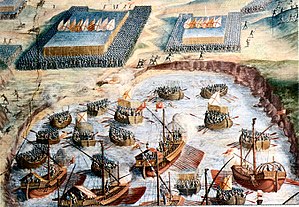War of the Portuguese Succession
| War of the Portuguese Succession | |||||||||
|---|---|---|---|---|---|---|---|---|---|
 Habsburg Tercios landing at the Battle of Ponta Delgada |
|||||||||
|
|||||||||
| Belligerents | |||||||||
|
|
|
||||||||
| Commanders and leaders | |||||||||
|
|
|
||||||||
Decisive Spanish victory
The War of the Portuguese Succession, a result of the extinction of the Portuguese royal line after the Battle of Alcácer Quibir and the ensuing Portuguese succession crisis of 1580, was fought from 1580 to 1583 between the two main claimants to the Portuguese throne: António, Prior of Crato, proclaimed in several towns as King of Portugal, and Philip II of Spain, who eventually succeeded in claiming the crown, reigning as Philip I of Portugal.
The Cardinal Henry, great-uncle of Sebastian I of Portugal, became ruler in the immediate wake of Sebastian's death. Henry had served as regent for Sebastian after 1557, and succeeded him as King after the disastrous Battle of Alcácer Quibir in 1578. Henry renounced his clerical offices and sought to take a bride for the continuation of the Aviz dynasty, but Pope Gregory XIII, affiliated with the Habsburgs, did not release him from his vows. The Cardinal-King died two years later, without having appointed a Council of Regency to choose a successor.
Portuguese nobility was worried about the maintenance of their independence and sought help to find a new King. By this time the Portuguese throne was disputed by several claimants; among them were Catherine, Duchess of Braganza (1540–1614), her nephew Ranuccio I Farnese, Duke of Parma, Philip II of Spain and António, Prior of Crato. The Duchess was later acknowledged by the Habsburgs as the legitimate heir, after her descendants obtained the throne in 1640 (in the person of John IV of Portugal), but at that time, she was only one of several possible heirs. According to the feudal custom, her late older sister's son Ranuccio, an Italian, was the closest heir, then the Duchess herself, and only after them, King Philip. Philip II of Spain was a foreigner (although his mother was Portuguese) and descended from Manuel I by a female line; as for António, although he was Manuel I's grandson in the male line, he was an illegitimate grandson.
...
Wikipedia
